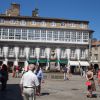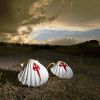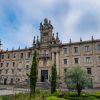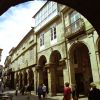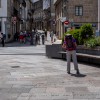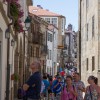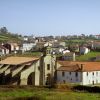- Accede I
- Regístrate I
- carrito
12. Plaza del Toural
12. Plaza del Toural
Galería de imágenes

La plaza de O Toural era un antiguo punto de venta de ganado y aprovisionamiento de agua. Sus casas señoriales de balcones forjados, muestran en los escudos nobles y galerías de cristal un buen catálogo de arquitectura tradicional compostelana.
Frente a la fuente del año 1822 puede verse el Pazo de Bendaña, palacio urbano del siglo XVIII, obra de Clemente Fernández Sarela. Remata su fachada la figura de Atlas que sostiene la bóveda celeste. En la actualidad, alberga a la Fundación Granell y el museo del mismo nombre, que recoge el legado del artista surrealista Eugenio Granell.
También sobresale en una de las viviendas una inmensa galería acristalada. Los visitantes que procedan del norte de España encontrarán en ella un elemento familiar. Y es que estas ‘trampas para el sol’ son señas de identidad de la arquitectura de la España septentrional, especialmente en los pueblos marineros. Su funcionamiento es sencillo y se basa en un principio similar al de los invernaderos. En invierno su misión es la de calentar la habitación contigua. Para ello se dejan abiertas las puertas de comunicación, que dejan pasar la luz del sol, mientras las ventanas permanecen cerradas. Llegado el verano tampoco hay que abrir las cristaleras, basta con hacer circular el aire por los ventanucos laterales, para que la corriente refresque la habitación anexa, mientras sus puertas permanecen cerradas.
Saliendo por el cantón de O Toural, avanzaremos por la calle de As Orfas, llamada así por la presencia de un convento fundado en el siglo XVII, en el que recibían enseñanza las niñas huérfanas de la ciudad. Su fachada barroca sorprende en medio de una sucesión de calles eminentemente comerciales, como la de Orfas y Calderería. Esta última recuerda, con su sonoro nombre, que Santiago fue y es una ciudad de buenos artesanos, que supo recibir a través del Camino de Santiago la tradición artesanal de toda Europa. La producción incluye orfebrería, velas, imágenes sagradas, cerámica, grabado, objetos de forja ornamental, vidrio, esmalte, tejidos o cuero.
Esta intensa actividad artesanal tenía que dejar su marca en el mapa compostelano. Es el caso de los barrios de Concheiros y Pelamios, donde se concentraban los vendedores de conchas y los curtidores de pieles, respectivamente, o las plazas de Platerías y Azabachería. Además, un oficio dio origen al gentilicio popular de picheleiros con el que se conoce a los compostelanos. La voz procede de ‘pichel’, es decir, ‘jarra de estaño’, y hace suponer que el trabajo de ese metal para barriles, lecheras y menaje estuvo largamente afincado en la ciudad, probablemente en esta calle que lleva el nombre de Calderería.










